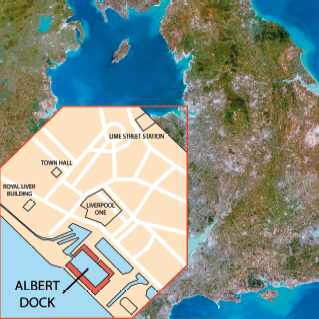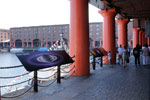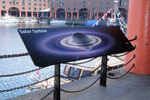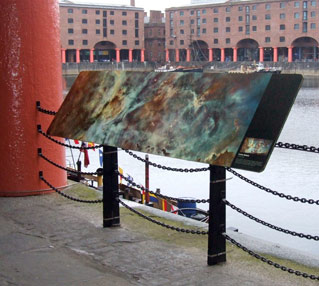Liverpool exhibition prototype in 2008
![]()

This unique venue is in the heart of Liverpool's historic dock area, a designated UNESCO World
Heritage Site and UK Grade I Listed buildings. The majority of the dock is surrounded by these
colonnades, formerly loading bays.
Plans are proceeding to have a prototype FETTU exhibition in June 2008 in Liverpool, UK that will showcase up to 75 large images of astronomical objects. The prototype is being planned with principal sponsorship from Science Photo Library. By undertaking this "dry run", the hope is that more information will soon be provided to local organizers throughout the world. This prototype will provide better estimates on issues such as cost and will additionally help us identify details we have not anticipated.
 Selection of the Albert Dock in Liverpool followed from considering the criteria suggested by the cornerstone project:
Selection of the Albert Dock in Liverpool followed from considering the criteria suggested by the cornerstone project:
VISIBILITY - Liverpool has been designated the European Capital of Culture for 2008, and is already the focus of a wide variety of public events.
ACCESSIBILITY - The Albert Dock is within an easy walk of the main railway terminus in Liverpool, and is in an area well served by public transportation. The dockside is accessible by wheelchair users. The colonnade around the dock feels like an open-air venue, even though it is actually covered.
POPULARITY - Surveys suggest 64% of visitors to Liverpool visit the Albert Dock. It has many popular attractions (such as the Tate Liverpool gallery), and several well-known restaurants. It is also adjacent to the new Convention and Exhibition Centre.
SUITABILITY - The Albert Dock is a UNESCO World Heritage Site. The adjacent Convention Centre is hosting the ASTRONET symposium in June 2008.

The location itself offers ideas for mounting the exhibit. In the Albert Dock, it seemed obvious to mount the images between the pillars of the colonnade surrounding the main dock area. This maximises the visibility of the exhibit, whilst allowing casual viewers to walk past with ease. This also minimises the Health and Safety impact.
The protected status of the buildings of the Dock means that normal mounting ideas are not allowed - no material alteration can be made to the fabric of the building in any way (e.g. drilling holes for supports). A preliminary concept was to suspend the images by cables between the columns, using existing loading rings and chain mountings. Although very attractive, this proved extremely expensive to implement and complex to achieve.
In its place, a design was selected which mounts the boards on posts bound to the existing chain stanchions found between the columns. The display will be created using 26 boards, each of which is 3 metres wide and 0.8 metres high. The images are printed by an ink-jet method directly onto aluminum. The aluminum is bonded to a plywood support from strength. The mounting posts are then fixed to the boards. The ink being used is weatherproof, so requires no further treatment. A major benefit of this direct ink-jet solution is that the entire length of the 3 metre panel is printed in one go. This new approach means that the panels can be designed in a dynamic and attractive style making good use of the 'letter box' shape. Designs being considered include the solar eclipse sequence above, and a full-width print of the entire Milky Way.
A few words of advice to potential image exhibition organisers, coming from our experience so far...
-
START PLANNING NOW - you won't believe how quickly time passes. Planning now will save many headaches later.
-
HAVE A PLAN B - and a Plan C, Plan D, E and all the way to Z if possible. Nothing will go according to the first plan. We even had to change host country!
-
KEEP COMMUNICATING - keep everyone involved in the loop and discuss thing widely. You never know what experience other people can bring along.
-
THINK LIKE YOUR AUDIENCE - make the image selection and design discussions from the lay person's viewpoint — ask friends and family for opinions.
See you in Liverpool, 7th to 29th June 2008!
UPDATES
Download the individual high-res images from the panels
(20 June 2008)
Disclaimer: these images may only be used for FETTU related purposes. The login and password to access the files are available upon request, send us an email
Panel A - Moon and Sun (zip file, 173 MB)
Panel B - Solar System (zip file, 54 MB)
Panel C - Stars (zip file, 781 MB)
Panel D - Star Birth (zip file, 948 MB)
Panel E - Star Deaths (zip file, 384 MB)
Panel F - Galaxies (zip file, 579 MB)
Panel G - Deep Sky (zip file, 59 MB)
Panel H - The Outer Limit (zip file, 180 MB)
![]()
FETTU Liverpool is up and running and looking good!
(16 June 2008)
We have had publicity in the local newspapers and hearing good feedback.






More pictures and information about the event is on the Chandra Blog
![]()
Liverpool FETTU exhibit
(28 May 2008)

View the final image panels (PDF 11.44 MB) of the Liverpool prototype exhibit .
The images are reduced in quality so it would be a reasonable download size, but it gives a good feel for the exhibit if you can't visit in person. The materials attempt to strike a balance between popular appeal, education, and mixing enough images without letting the casual viewer get overloaded. The schedule is on for installation on 5-6 June, in time for the 7 June announced opening.
![]()
Update from Gary Evans, Liverpool FETTU organizer
(28 April 2008)
 Recently, I went up to Liverpool for the trial installation last Friday. After some negotiation, we now have the
agreement of all the stakeholders in this project - site management, site
owners, heritage officials, tennants and residents - and clearance by security
and health & safety officers.
The print itself is awesome - at three metres long the Carina nebula has to
be a winner anyway. Very impressed with the quality of the print itself in
terms of colour and tone reproduction. The mounting on aluminium looks
very high-class, especially as we have had a radius cut on the corners (no
sharp edges!).
During discussions we decided on the slightly lower setting for the panel.
This has a great benefit of making the captions more accessible to children
or wheelchair users, for example, and also increases the natural lighting. I
don't believe it has any impact on the visibility of the panels as such.
The panel was left in place for a few hours, and I'd say 50% of people walking
along the dockside stopped to look at the panel, and about one in six looked
at the caption. I think this completely validates the reasoning behind FETTU,
the average person on the street is attracted to these images and I have
every confidence that the Liverpool prototype will be a huge success. In the image above: trial installation of an actual image panel at the Liverpool site.
Recently, I went up to Liverpool for the trial installation last Friday. After some negotiation, we now have the
agreement of all the stakeholders in this project - site management, site
owners, heritage officials, tennants and residents - and clearance by security
and health & safety officers.
The print itself is awesome - at three metres long the Carina nebula has to
be a winner anyway. Very impressed with the quality of the print itself in
terms of colour and tone reproduction. The mounting on aluminium looks
very high-class, especially as we have had a radius cut on the corners (no
sharp edges!).
During discussions we decided on the slightly lower setting for the panel.
This has a great benefit of making the captions more accessible to children
or wheelchair users, for example, and also increases the natural lighting. I
don't believe it has any impact on the visibility of the panels as such.
The panel was left in place for a few hours, and I'd say 50% of people walking
along the dockside stopped to look at the panel, and about one in six looked
at the caption. I think this completely validates the reasoning behind FETTU,
the average person on the street is attracted to these images and I have
every confidence that the Liverpool prototype will be a huge success. In the image above: trial installation of an actual image panel at the Liverpool site.
-Gary Evans

